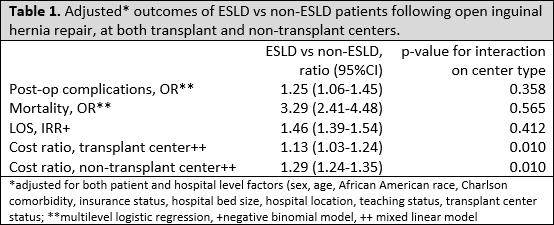Outcomes Following Inguinal Hernia Repair in Patients with End Stage Liver Disease.
Transplant Surgery, Johns Hopkins Hospital, Baltimore.
Meeting: 2016 American Transplant Congress
Abstract number: B263
Keywords: Liver, Liver failure, Surgical complications
Session Information
Session Name: Poster Session B: Liver: MELD, Allocation and Donor Issues (DCD/ECD)
Session Type: Poster Session
Date: Sunday, June 12, 2016
Session Time: 6:00pm-7:00pm
 Presentation Time: 6:00pm-7:00pm
Presentation Time: 6:00pm-7:00pm
Location: Halls C&D
Increased abdominal pressure and girth from ascites puts patients with end stage liver disease (ESLD) at high risk for inguinal hernia as well as challenges with surgical repair. This study investigates outcomes of ESLD patients following inguinal hernia repair using a nationwide dataset.
METHODS: Using data from the Nationwide Inpatient Sample, we studied 8166 patients with ESLD and 340,000 non-ESLD patients who underwent open inguinal hernia repair between 2000-2011, including those requiring elective, urgent, or emergent repair. Location of surgery at either a transplant or non-transplant center was also compared. ICD-9 codes were used to categorize complications. Multilevel logistic, negative binomial, and linear mixed models were used to compare complications, LOS and cost respectively.
RESULTS: A majority of ESLD and non-ESLD patients underwent repair at non-transplant centers (83.9% vs 92.5%). Mortality among ESLD patients was higher than non-ESLD patients (3.7% vs 1.2%, p <0.001). This association was significant after adjustment for patient and hospital factors, and did not differ by center type (OR 3.29; 95%CI 2.41-4.48; interaction p=0.57). Adjusted odds of having postoperative complications on primary admission were higher for ESLD patients (OR 1.25; 95%CI 1.06-1.45). Median LOS for ESLD patients was 4d vs 2d (IRR 1.46; 95%CI 1.39-1.54), and median hospital cost for ESLD patients was $8571 vs $5699 (cost ratio 1.29; 95%CI 1.24-1.35). Further, ESLD patients at transplant centers incurred significantly costs than at non-transplant centers (interaction p=0.010). 
CONCLUSIONS: ESLD patients have a higher postoperative mortality, complication rate and longer length of stay following inguinal hernia repair than non-ESLD patients, regardless of center type. ESLD patients undergoing inguinal hernia repair have a significantly higher median hospital cost at non-transplant centers. From the perspective of cost, ESLD patients should undergo inguinal hernia repair at transplant centers.
CITATION INFORMATION: Dagher N, DiBrito S, Olorundare I, Landazabal C, Segev D. Outcomes Following Inguinal Hernia Repair in Patients with End Stage Liver Disease. Am J Transplant. 2016;16 (suppl 3).
To cite this abstract in AMA style:
Dagher N, DiBrito S, Olorundare I, Landazabal C, Segev D. Outcomes Following Inguinal Hernia Repair in Patients with End Stage Liver Disease. [abstract]. Am J Transplant. 2016; 16 (suppl 3). https://atcmeetingabstracts.com/abstract/outcomes-following-inguinal-hernia-repair-in-patients-with-end-stage-liver-disease/. Accessed December 20, 2025.« Back to 2016 American Transplant Congress
